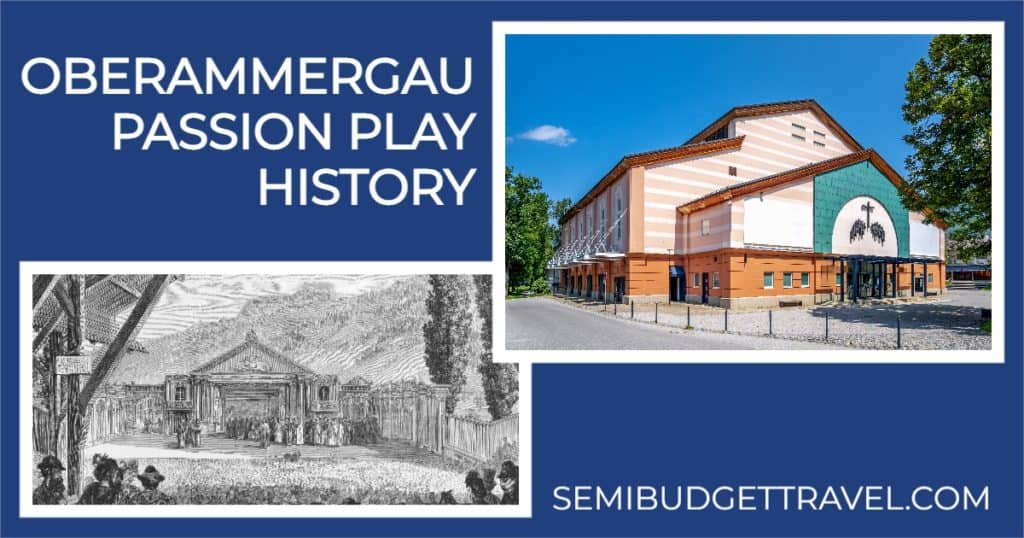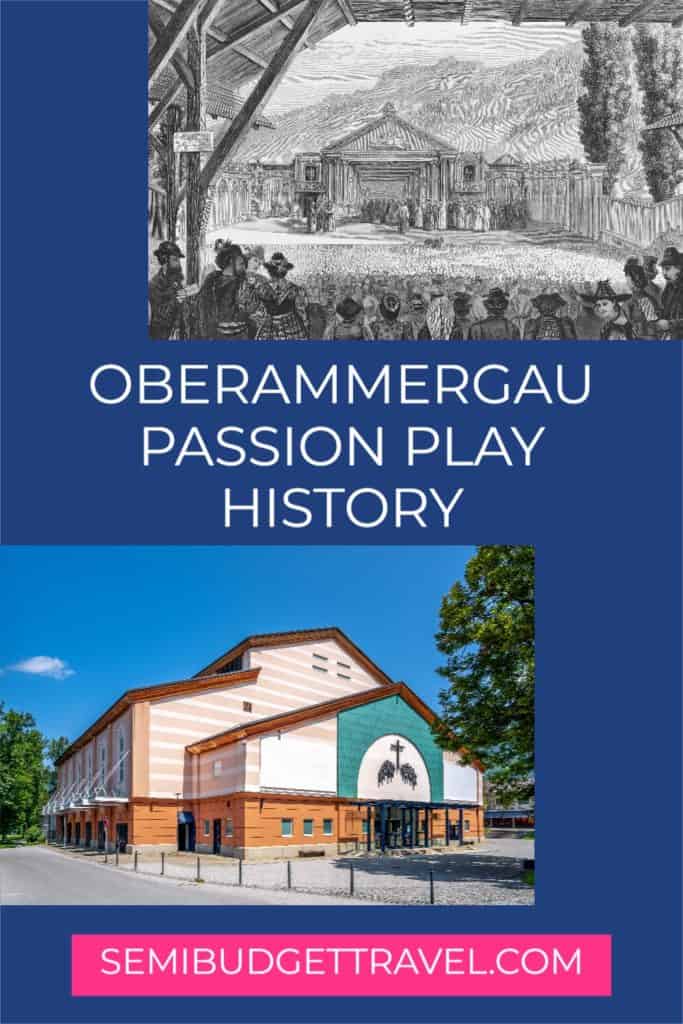This post may contain affiliate links. Please read our Disclosure Policy for more information.

If you’re like me, you love a good history lesson wrapped up in a travel package. I’m always looking for new and interesting ways to learn about the world.
Most people think of the Oberammergau Passion Play as just a small town tourist destination, but it’s so much more than that. This event is steeped in history and tradition.
The Oberammergau Passion Play has been performed every ten years since 1634, with few exceptions (such as world wars), and 2022 will mark the 42nd Play Year. This event is one of the longest-running stage plays in the world, and it’s sure to be an experience you’ll never forget.
HI THERE! DON’T FORGET TO PIN THIS FOR LATER!

- A Brief History of the Oberammergau Passion Play
- Oberammergau Passion Play History Timeline
- Why is it called a Passion Play?
- Why is the Oberammergau Passion Play so significant?
- Other Historical Significance
- Who performs the Oberammergau Passion Play?
- Is the Oberammergau Passion Play in English?
- How long does the Oberammergau Passion Play last?
- Is the Oberammergau Passion Play worth seeing?
- SBT Summary: Oberammergau Passion Play History
A Brief History of the Oberammergau Passion Play
The famous Oberammergau Passion Play is a unique event that has been held in the small Bavarian village of Oberammergau, Germany for centuries. The play tells the story of the crucifixion and resurrection of Jesus Christ, and it is traditionally performed by the residents of Oberammergau.
“Once every 10 years.” That vow was made in 1633, which is when the history of the Oberammergau Passion Play begins.
When was the first Passion Play in Oberammergau?
The play first began in 1634, when the residents of Oberammergau promised to perform a Passion Play every ten years in order to thank God for sparing their town from the bubonic plague, or black plague (in additional to navigating the trials of the Thirty Years War). There were no further deaths. Since then, in fulfillment of a vow, the play has been performed numerous times, most recently in 2010.
The play is an immensely popular tourist attraction, drawing visitors from all over the world to experience this unique piece of history.
Oberammergau Passion Play History Timeline
1634 (1st Play Year) – It is said that this first keeping of the vow was performed in the cemetery where many of those who had succumbed to the plague were buried.
1644 (2nd Play Year)
1654 (3rd Play Year)
1664 (4th Play Year)
1674 (5th Play Year) – After this year, it is decided to switch to performing the play in years ending in “zero.”
1680 (6th Play Year)
1690 (7th Play Year)
1700 (8th Play Year)
1710 (9th Play Year)
1720 (10th Play Year) – parts of the preserved text indicate a scenery stage in the Baroque style
1730 (11th Play Year) (2 performances)
1740 (12th Play Year)
1750 (13th Play Year) (nearly 11,000 attendees) – tableaux vivants (“living images”) are utilized
1760 (14th Play Year) (14,000 attendees)
1770 (none) – cancelled by Elector Maximilian III’s Clerical Council, claiming the theater stage is no place for religion
1780 (15th Play Year) – special permission to perform again, with several restrictions
1790 (16th Play Year) (5 performances) (11,000 attendees)
1800 (17th Play Year) (5 performances) (3,000 attendees) – reduction in visitors, due to Napoleonic Wars and battles nearby – French looted Oberammergau!
1801 (18th Play Year) (4 performances) – continuation from 1800, but short lived
1810 (none) – religious limitations restrict Passion Play again
1811 (19th Play Year) (5 performances) – the evolution of the Passion Play continues, as new text is written, and the ban is revoked
1815 (20th Play Year) (11 performances)
1820 (21st Play Year) (10 performances) (19,000 attendees) – the last year the Passion Play is performed at the cemetery
1830 (22nd Play Year) (11 performances) (300 participants) (13,000 attendees) – stage and theater relocated from cemetery to north end of Oberammergau and can seat 5,000
1840 (23rd Play Year) (35,000 attendees)
1850 (24th Play Year) (14 performances) (45,000 attendees)
1860 (25th Play Year) (21 performances) (100,000 attendees)
1870/1871 (26th Play Year) (500 participants) (40,000 attendees) – performances stretched over two years, due to war with France – well-known, distinguished guests attend, including King Ludwig II, the future King Edward VII of England, and composer Franz Liszt
1880 (27th Play Year) (100,000 attendees)
1890 (28th Play Year) (40 performances) (124,000 attendees) – stage is modernized a bit and seats have a partial roof
1900 (29th Play Year) (174,000 attendees) – new auditorium with 4,200 seats – Looking forward, “Play Law” enacted on 11/29/1901 stating that participation is limited to those “who have been resident in the community since 1900 and were involved in the municipal theatre in the nine intervening years.”
1910 (30th Play Year) (56 performances) (223,548 attendees) – distinguished guests include U.S. President William Howard Taft, conductor and composer Richard Strauss, King Gustav V. of Sweden, and the future Pope Pius XI
1920 (none) – cancelled in 1918 – postponed to 1922, due to post-World War I economic and political conditions
1922 (31st Play Year) (311,127 attendees, including 100,000 foreigners) – distinguished guests include future U.S. President Herbert Hoover, future Pope Pius XII, and composer Giacomo Puccini
1930 (32nd Play Year) (380,000 attendees) – new stage is built, and auditorium now seats 5,280 – distinguished guests include Henry Ford, Queen Elisabeth of Greece, and UK Prime Minister James Ramsay MacDonald – Adolf Hitler attends on July 21
1934 (33rd Play Year) (410,000 attendees) – additional performances to celebrate 300th anniversary – the Passion Play is affected, however, by the Third Reich’s propaganda – Adolf Hitler attends (on August 13), as well as William R. Hearst
1940 (none) – cancelled, due to World War II
1950 (34th Play Year) (87 performances, from a planned 33) (480,000 attendees) – distinguished guests include future U.S. President Dwight D. Eisenhower
1960 (35th Play Year)
1970 (36th Play Year) (102 performances) (530,000 attendees)
1977 (“Rosner Rehearsal”) (8 performances) (700 participants)
1980 (37th Play Year) (460,000 attendees) – seating in auditorium reduced to 4,700 – this is the first year that leading roles are cast with two equal actors – distinguished guests include future Pope Benedict XVI
1984 (38th Play Year) (480,000 attendees) – additional performances to celebrate 350th anniversary – married women & women over 35 years old can now participate
1990 (39th Play Year) (98 performances) (480,000 attendees) – beginning prior to this year’s production, all actors, soloists, and the director make a 10-day journey to Israel
2000 (40th Play Year) (110 performances) (1,600 adult & 550 children participants) (520,000 attendees) – auditorium renovated & given new façade – Muslim citizens of Oberammergau can now participate with Christian citizens
2010 (41st Play Year) (109 performances) (2,400 participants) (515,000 attendees) – performances move from “morning-lunch break-afternoon” to “afternoon-dinner break-evening,” thus the Crucifixion scene is now at nighttime – movable stage roof added – first complete recording made
2020 (none) – postponed to 2022, due to worldwide coronavirus pandemic
2022 (42nd Play Year)
2030 (43rd Play Year)
Why is it called a Passion Play?
The term “Passion” is derived from the Latin word pati, which means “suffering,” so it’s a play of the suffering of Jesus. Passion Plays are a form of religious theatre that depict the final days of Jesus Christ, leading up to his crucifixion. Passion Plays typically take place during the weeks before Easter.
While the origins of Passion Plays are not entirely clear, it is believed that they began in the medieval era as a way to explain the Easter story to a largely illiterate population. Today, Passion Plays are still performed in many parts of the world (including, of course, Oberammergau), and they continue to be a popular way to tell the story of Jesus’ sacrifice.
In Oberammergau, the New Testament account of the Passion of Jesus Christ is interspersed with tableaux vivants (“living images”) of Old Testament scenes.
Why is the Oberammergau Passion Play so significant?
The Oberammergau Passion Play is one of the oldest and most famous theatrical productions in the world. First performed in 1634, it tells the story of the crucifixion of Jesus Christ. Every ten years, the play is reenacted by a cast of local villagers, many of whom have been involved in the production for their entire lives.
The history of the Passion Play is significant not only for its age, but also for its depiction of religious themes. For centuries, it has provided a powerful and moving portrayal of Christ’s sacrifice, and continues to inspire viewers from all over the globe.
The performers take their participation very seriously, as does the Community Council. Each Ash Wednesday, in the year preceding the performances, the hair and beard decree goes into effect. All the performers begin letting their hair grow out, and men start growing beards.
In addition, the play is a remarkable example of the endurance of human tradition. For nearly 400 years, the villagers of Oberammergau have come together to perform the Passion Play, ensuring that this unique and important production will continue to be seen for many years to come.
Other Historical Significance
The Oberammergau Passion Play Theatre is now considered a “monument” by the Bavarian State Office for Monument Conservation.
The Passion Play itself is listed as intangible heritage of the Federal Republic of Germany on the UNESCO World Cultural Heritage List.
Who performs the Oberammergau Passion Play?
The play is performed by a cast of over 2,000 residents (the people of Oberammergau!), all of whom have been born in Oberammergau or have lived there for at least 20 years.
It has been directed by Christian Stückl, an Oberammergau native, since 1990.
Is the Oberammergau Passion Play in English?
The short answer is no, the Oberammergau Passion Play is not in English. However, that doesn’t mean that English speakers can’t enjoy this world-famous performance.
The play is presented in German, with no surtitles. Books with translation into various languages are available for purchase at the time of your scheduled performance.
But, even if you don’t understand German, the impressive sets and costumes are sure to leave a lasting impression. So whether you’re a drama enthusiast or simply looking for a unique cultural experience, a trip to Oberammergau is sure to be an unforgettable experience.
How long does the Oberammergau Passion Play last?
For the 42nd Play Year of 2022, there are 103 scheduled performances from May 14 through October 2.
The running time of each performance is 5 hours total, in two 2.5-hour segments, with a meal break in between.
From May 14 through August 14, 2022, the segments will be 2:30 p.m. – 5:00 p.m., and 8:00 p.m. – 10:30 p.m. local time.
From August 15 through October 2, 2022, the segments will be 1:30 p.m. – 4:00 p.m., and 7:00 p.m. – 9:30 p.m. local time.
Is the Oberammergau Passion Play worth seeing?
If you’re looking for a once-in-a-lifetime experience, the Passion Play of Oberammergau is definitely worth seeing.
The play is performed entirely by amateur actors from the town, many of whom have been involved in the production for their entire lives. In addition to the acting, the play features beautiful costumes, elaborate sets, and live animals. It’s truly a sight to behold.
The music is also fantastic, as the choir and orchestra guide you through the entire performance.
So, start planning your trip to a little town in the Bavarian Alps of southern Germany for this historic event. You can opt for package tours, which include hotel accommodations, or you can purchase tickets for the Passion Play performance only (which will be a bit more semi-budget travel friendly). We’ve got further information for you about this unique experience!
SBT Summary: Oberammergau Passion Play History
The Oberammergau Passion Play is an incredible piece of living history, and it’s definitely worth making the trip to see it…whether it’s your first time or your third, like me!
ENJOYED THIS POST? PIN IT FOR LATER!

STARTS WITH
A GREAT BUDGET!

ALL GREAT SEMI-BUDGET TRAVEL
It's easy! I will show you how with a FREE trip planning tool.







